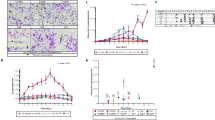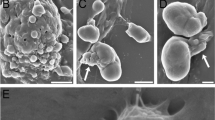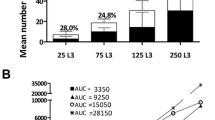Abstract
As observed in most of the investigated trichomonads, a strain of Tritrichomonas foetus includes different parasite subpopulations. Such population diversity might account for important properties such as the ability of the parasite to destroy host cells. The aim of this study was to characterize the cytotoxicity exerted by subpopulations (named as K1, K2, K3, K4 and K5) of an isolate of T. foetus on epithelial cultured cells. The five populations studied here destroyed epithelial monolayers at different rates (from 25% to 55%), even though the cytoadhesion level and whole-cell protease activity were closely related among them. We were also able to detect differences in contact-dependent and contact-independent cytotoxicity mechanisms among the five populations. An extracellular parasite protease had varying activity among the parasite populations. The intensity of contact-independent cytotoxicity was strictly related to the degree of enzyme activation, suggesting that such a protease might be involved in the cytotoxicity mediated by T. foetus.





Similar content being viewed by others
References
Alderete JF, Kasmala L, Metcalfe E, Garza G (1986) Phenotypic variation and diversity among Trichomonas vaginalis isolates and correlation of phenotype with trichomonal virulence determinants. Infect Immun 53:285–293
Alderete JF, Arroyo R, Lehker MK (1995) Analysis for adhesions and specific cytoadhesion of Trichomonas vaginalis. Methods Enzymol 253:407–414
Alvarez-Sanchez ME, Avila-Gonzalez L, Becerril-Garcia C, Fattel-Facenda LV, Ortega-Lopez J, Arroyo R (2000) A novel cysteine proteinase (CP65) of Trichomonas vaginalis involved in cytotoxicity. Microb Pathog 28:193–202
Bastida-Corcuera F, Butler JE, Heyermann H, Thomford JW, Corbeil LB (2000) Tritrichomonas foetus extracellular cysteine proteinase cleavage of bovine IgG2 allotypes. J Parasitol 86:328–332
Bonilha VL, Saraiva EMB, Silva-Filho FC (1993) Effect of a phorbol ester on basic properties of trichomonads. Cell Biophys 20:1–15
Bradford MM (1976) A rapid and sensitive method for the quantification of microgram quantities of proteins utilizing the principle of protein-dye binding. Ann Biochem 72:248–254
Burgess DE, McDonald CM (1992) Analysis of adhesion and cytotoxicity of Tritrichomonas foetus to mammalian cells by use of monoclonal antibodies. Infect Immun 60:4253–4259
Burgess DE, Knoblock KF, Daugherty T, Robertson NP (1990) Cytotoxic and hemolytic effects of Tritrichomonas foetus on mammalian cells. Infect Immun 58:3627–3632
Connaris S, Greenwell P (1997) Glycosidases in mucin-dwelling protozoans. Glycoconj J 14:879–882
Cuba-Cuba CA, Evans D, Rosa AC, Marsden PD (1991) Clonal variation within a mucosal isolate derived from a patient with Leishmania braziliensis infection. Rev Inst Med Trop Sao Paulo 33:343–350
Felleisen RSJ (1999) Host-parasite interaction in bovine infection with Tritrichomonas foetus. Microbes Infect 1:807–816
Fiori PL, Rappelli P, Addis MF, Sechi A, Cappuccinelli P (1996) Trichomonas vaginalis haemolysis: pH regulates a contact-independent mechanism based on pore-forming proteins. Microb Pathog 20:109–118
Galán JE, Pace J, Hayman MJ (1992) Involvement of the epidermal growth factor receptor in the mammalian cells by Salmonella typhimurium. Nature 357:588–589
Hirt RP, Lal K, Pinxteren J, Warwicker J, Healy B, Coombs GH, Field MC, Embley TM (2003) Biochemical and genetic evidence for a family of heterotrimeric G-proteins in Trichomonas vaginalis. Mol Biochem Parasitol 129:179–189
Honigberg BM (1978) Parasitic protozoa. Academic Press, New York, pp 164–273
Hook RR Jr, St Claire MC, Riley LK, Franklin CL, Besch-Williford CL (1995) Tritrichomonas foetus: comparison of isolate virulence in an estrogenized mouse model. Exp Parasitol 81:202–207
Kania SA, Reed SL, Thomford JW, BonDurant RH, Hirata K, Corbeil RR, North MJ, Corbeil LB (2001) Degradation of bovine complement C3 by trichomonad extracellular proteinase. Vet Immunol Immunopathol 78:83–96
Keene WE, Hidalgo ME, Orozco E, McKerrow JH (1990) Entamoeba histolytica: correlation of the cytopathic effect of virulent trophozoites with secretion of a cysteine proteinase. Exp Parasitol 71:199–206
Kennett MJ, Hook RR Jr (2002) Tritrichomonas foetus: characterization of isolates and partial purification of a secreted cytotoxin. Exp Parasitol 102:1–8
Khan NA, Jarroll EL, Panjwani N, Cao Z, Paget TA (2000) Proteases as markers for differentiation of pathogenic and nonpathogenic species of Acanthamoeba. J Clin Microbiol 38:2858–2861
Klemba M, Goldberg DE (2002) Biological roles of proteases in parasitic protozoa. Annu Rev Biochem 71:275–305
Laemmli UK (1970) Cleavage of structural proteins during the assembly of the head of bacteriophage T4. Nature 227:680–685
Lockwood BC, North MJ, Coombs GH (1984) Trichomonas vaginalis, Tritrichomonas foetus, and Trichomitus batrachorum: comparative proteolytic activity. Mol Biochem Parasitol 58:245–253
Lockwood BC, North MJ, Coombs GH (1988) The release of hydrolases from Trichomonas vaginalis and Tritrichomonas foetus. Mol Biochem Parasitol 30:135–142
López LB, Melo-Braga MB, Lopez JO, Arroyo R, Silva-Filho FC (2000) Strategies by which some pathogenic trichomonads integrate diverse signals in the decision-making process. An Acad Bras Cienc 72:173–186
Lubick KJ, Burgess DE (2004) Purification and analysis of a phospholipase A2-like lytic factor of Trichomonas vaginalis. Infect Immun 72:1284–1290
Lun ZR, Parker S, Gajadhar AA (2000) Comparison of growth rates of Tritrichomonas foetus isolates from various geographic regions using three different culture media. Vet Parasitol 89:199–208
Melo-Braga MB, Rocha-Azevedo B, Silva-Filho FC (2003) Tritrichomonas foetus: the role played by iron during parasite interaction with epithelial cells. Exp Parasitol 105:111–120
Petrin D, Delgaty K, Bhatt R, Garber G (1998) Clinical and microbiological aspects of Trichomonas vaginalis. Clin Microbiol Rev 11:300–317
Phillips HJ, Terryberry JE (1957) Counting actively metabolizing tissue culture cells. Exp Cell Res 13:341–347
Revollo S, Oury B, Laurent JP, Barnabe C, Quesney V, Carriere V, Noel S, Tibayrenc M (1998) Trypanosoma cruzi: impact of clonal evolution of the parasite n its biological and medical properties. Exp Parasitol 89:30–39
Samuels R (1962) Agar techniques for colonizing and cloning trichomonads. J Protozool 9:103–107
Silva-Filho FC, de Souza W (1988) The interaction of Trichomonas vaginalis and Tritrichomonas foetus with epithelial cells in vitro. Cell Struct Funct 13:301–310
Silva-Filho FC, Elias CA, de Souza W (1982) The surface charge of Tritrichomonas foetus. J Protozool 29:551–555
Silva-Filho FC, Saraiva EMB, Tosta MX, de Souza W (1989) Trichomonas vaginalis and Tritrichomonas foetus secrete neuraminidase into the culture medium. Mol Biochem Parasitol 35:73–78
Singh BN, Lucas JJ, Beach DH, Shin ST, Gilbert RO (1999) Adhesion of Tritrichomonas foetus to bovine vaginal epithelial cells. Infect Immun 67:3847-3854
Skirrow S, BonDurant RH (1988) Bovine trichomoniasis. Vet Bull 58:591–603
Talbot JA, Nielsen K, Corbeil LB (1991) Cleavage of proteins of reproductive secretions by extracellular proteinases of Tritrichomonas foetus. Can J Microbiol 37:384–390
Acknowledgements
This work has been supported by the following Brazilian agencies: CNPq, MCT-PRONEX, FUJB-UFRJ, and FAPERJ. The experiments related in this manuscript are in agreement with the current laws of Brazil.
Author information
Authors and Affiliations
Corresponding author
Rights and permissions
About this article
Cite this article
da Rocha-Azevedo, B., de Melo-Braga, M.B. & e Silva-Filho, F.C. Intra-strain clonal phenotypic variation of Tritrichomonas foetus is related to the cytotoxicity exerted by the parasite to cultured cells. Parasitol Res 95, 106–112 (2005). https://doi.org/10.1007/s00436-004-1251-0
Received:
Accepted:
Published:
Issue Date:
DOI: https://doi.org/10.1007/s00436-004-1251-0




